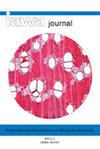卡尔奎斯特的年轮分类:一种强化多孔年轮和年轮的功能方法
IF 3.5
3区 农林科学
Q2 FORESTRY
引用次数: 1
摘要
毫无疑问,卡尔奎斯特是当代最伟大的木材解剖学家之一。该领域的每一位学生或研究人员都可能至少阅读过他的众多作品中的一本,很难在木材解剖学中找到一个不适合他的出版物的主题。在Carlquist提出的许多主题中,生长环当然是木材解剖学中最古老、最令人兴奋的主题之一。Carlquist根据解剖变异建立了生长环的功能分类,此外还将不同的解剖标记解释为“生态适应性装置”。在这篇文章中,我回到Carlquist对生长环的第一个分类,并在他后来的评论中总结了主要的变化。我强调了他对生长环前所未有的功能方法所带来的进步,同时也批评了Carlquist提出的生长环分类,该分类强化了一种局部观点,尽管直到今天仍占主导地位,但主要关注温带物种:生长环大多标记良好,多孔或半多孔,并具有年度周期性。本文章由计算机程序翻译,如有差异,请以英文原文为准。
Carlquist’s growth ring classification: a functional approach that reinforces porous and annual rings
There is no doubt that Carlquist is one of the greatest contemporary wood anatomists. Every student or researcher in the field is likely to have read at least one of his numerous works, and it is difficult to find a topic in wood anatomy that does not lead to one to his publications. Among the many topics addressed by Carlquist are of course growth rings, one of the oldest and most exciting topics in wood anatomy. Carlquist established a functional classification for growth rings based on anatomical variation, in addition to an interpretation of the different anatomical markers “as ecologically adaptive devices.” In this article, I return to Carlquist’s first classification of growth rings and summarize the main changes in his later reviews. I highlight the advances provided by his unprecedented functional approach to growth rings, while also criticizing Carlquist’s proposed growth ring classification, which reinforces a partial view, although dominant until the present day, focused on temperate species: that growth rings are mostly well marked, porous or semi-porous, and with annual periodicity.
求助全文
通过发布文献求助,成功后即可免费获取论文全文。
去求助
来源期刊

IAWA Journal
农林科学-林学
CiteScore
3.40
自引率
15.80%
发文量
26
审稿时长
>36 weeks
期刊介绍:
The IAWA Journal is the only international periodical fully devoted to structure, function, identification and utilisation of wood and bark in trees, shrubs, lianas, palms, bamboo and herbs. Many papers are of a multidisciplinary nature, linking
 求助内容:
求助内容: 应助结果提醒方式:
应助结果提醒方式:


